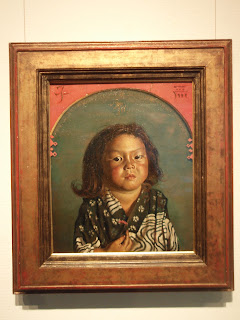When you think of Japanese art, you probably think of
scrolls, religious carvings and figures, and nature scenes on rice paper.
Modern Japanese art can be some of this, but there is so much more to the works
produced in the past century.
Ryusei Kishida: Reiko, Five Years Old
While this has a fairly traditional style, it still deviates
a bit from the “natural” scenes westerners associate with Japanese art.
Kanji Yo: Embracement under the Light
Some of the works are fairly erotic by western standards.
This beautiful sculpture depicts two naked figures in a passionate embrace
beneath a lamp. Many of the works on display from the museum’s collection went
with the special exhibition’s theme of nudity.
Iwami Furusawa: Pluto’s Daughter
While the theme of nudity is seen again here, this work is
both disturbing and attractive at the same time. Unfortunately I was unable to
read the Japanese text explaining the picture, but the use of the frightening
hands and feet and the nearly out-of-place wolf’s head with big eyes brings a
lot of fear into this viewer’s mind.
The museum itself is spread out well among several floors,
with the collection on display laid out by time period. It is easy to see the
change from more traditional artistic methods, including several nature scenes
on screens and scrolls, to the more modern emotion-inducing works similar to Pluto’s Daughter and the several
sculptures seen towards the end of the of the path. The museum lays out a very
clear path that brings you from room to room, and time period to time period,
very clearly. Unlike several western museums which are a maze of rooms, great
care was taken in determining a logical sequence to ensure a good traffic flow
and to be sure the viewers don’t miss any of the beautiful pieces on display.
An English guide was given to me when asked; though once I
entered the museum I saw several different language pamphlets available for the
taking. Each time period in the exhibit had an introduction printed on the wall
which was provided in both Japanese and English texts, and English text about
each time period (or main exhibit) is included in the guide. As the featured
exhibits change, I assume the collection on display changes as well, which
means visiting multiple times during the year can bring new and interesting
pieces of art.
The museum is located directly across from the Imperial
Gardens East, and can be reached by crossing two bridges – one over the “moat”
around the gardens, and the other over the busy adjacent street. Also in the
area is the science museum and the National Archives; several other attractions
can be found in the general area. Admission for the main building and Crafts
Gallery (which I didn’t take time to see, but I will see when I eventually revisit
the museum) was only 420 yen.
Please note that I mean no harm in posting images of artwork shown at the museum; I simply intend to give readers a small indication of the many wonderful works that are on display. These images are for no purpose other than to inform my readers and may not be copied or reproduced for any reason at all.



What? No cards??? Just kidding. It looks like you're really enjoying yourself.
ReplyDeleteHah! I have some cards to show sometime soon. I have to scan them and write the post. But there isn't anything too special yet.
ReplyDeleteRyan,
DeleteYou doing all right buddy?